Appendix D
White Paper: Does the Recent Increase in Computer Science Degrees Reflect Increased Demand?
Jennifer Hunt
Rutgers University and NBER1
October 6, 2016
ABSTRACT
Since 2009 there has been an increase in the number of computer and information science bachelor’s degrees similar in speed and magnitude to the increase induced by the 1990s dot-com and Y2K-related demand. However, both speed and magnitude are more modest than earlier booms when measured as a share of bachelor’s degrees awarded. Furthermore, there has been an equal increase in the share of engineering bachelor’s degrees, suggesting that common forces may be affecting the two fields. Data on employment and wages suggest the increase in computer science and engineering bachelor’s degrees is caused by the combination of a moderate shift out (increase) in labor demand and a moderate shift out (increase) in labor supply—that is, some of the increase in enrollment is responding to something other than wages. The shift out in demand may be caused by higher demand for quantitative skills, or new developments in the joint use of digital and mechanical technology, such as robotics. The shift out in supply may reflect a move toward recession-proof majors.
In this paper I assess possible reasons for the large increase since 2009 in bachelor’s degrees conferred in computer science (CS). I begin by documenting the rise in degrees awarded in computer science and related fields. I then examine employment and wages in computer science as well as engineering and natural science to examine whether the increased choice of computer science as a major appears to be responding to increased demand. I close by speculating what forces
___________________
1 Prepared for the National Academy of Sciences Committee on the Growth of Computer Science Undergraduate Enrollments. E-mail: jennifer.hunt@rutgers.edu.
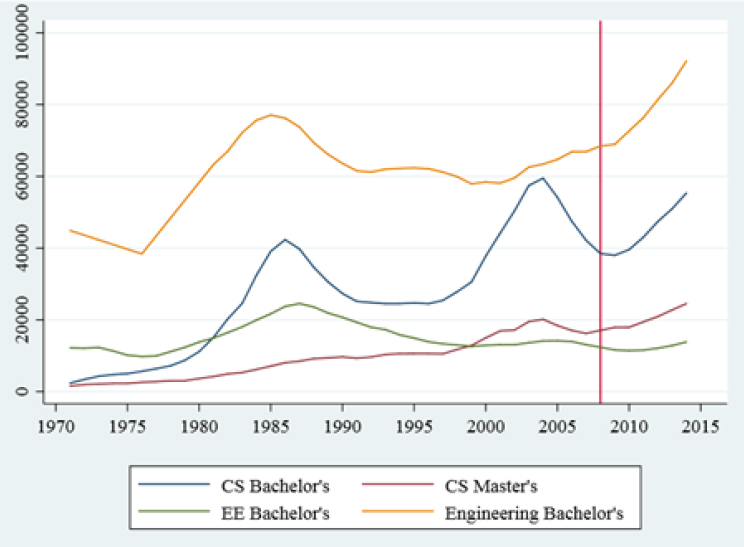
could be affecting demand for and supply of college-educated computer workers. I do not study increased enrollment in computer science by non-majors.
GROWTH IN COMPUTER SCIENCE DEGREES
In Figure D.1, the number of computer and information science (henceforth computer science) bachelor’s degrees awarded (blue line) shows the well-known cyclical pattern of boom and bust around an upward trend. Degrees awarded have risen sharply since 2009.2 Computer science masters’s degrees (red line) have trended upward but are almost acyclical, unlike computer science bachelor’s degrees, though they experienced a small echo of the early 2000s boom and bust; the trend pace of expansion has quickened since 2010. By comparison electrical engineering bachelor’s degrees (green line) shared in the boom and bust of the 1980s, but did not share the cycle of the 2000s and do not exhibit an upward trend, nor any unusual increase since 2009. Bachelor’s degrees in engineering as a whole (yellow line) differ from those in electrical engineering in experiencing strong growth in majors since 2000 and especially since 2009,
___________________
2 Data are available only through academic year 2013-2014.
driven by growth in most subfields other than electrical engineering, particularly mechanical engineering.
It is well known that there has been a large increase both in the number of students on temporary visas and in the number of foreign-born workers on temporary visas in the information technology industry, but Figure D.2 shows that recent trends in CS and engineering degrees awarded are not driven by students on temporary visas.
The sizes of the computer science booms and busts look different if one views them as a share of all bachelor’s degrees conferred. Figure D.3 shows that the pace at which computer science bachelor’s degrees have been expanding recently is much slower than in the two previous booms. If the trend continued at the same pace in 2015 and 2016, the cumulative magnitude of the recent boom would be about half the size of the 1990s boom.
Figure D.3 also shows that it is only since 2009 that engineering bachelor’s degrees have increased as a share of all bachelor’s degrees. In fact, Figure D.4 shows that the share of engineering degrees has evolved identically to the share
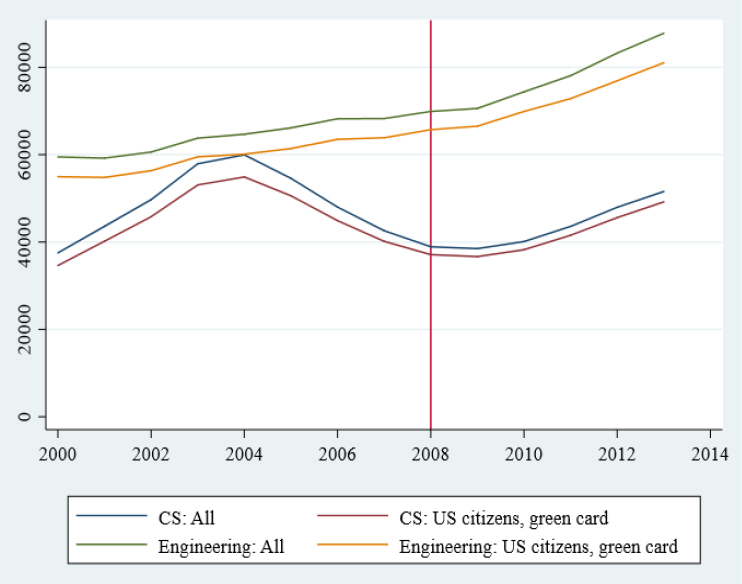
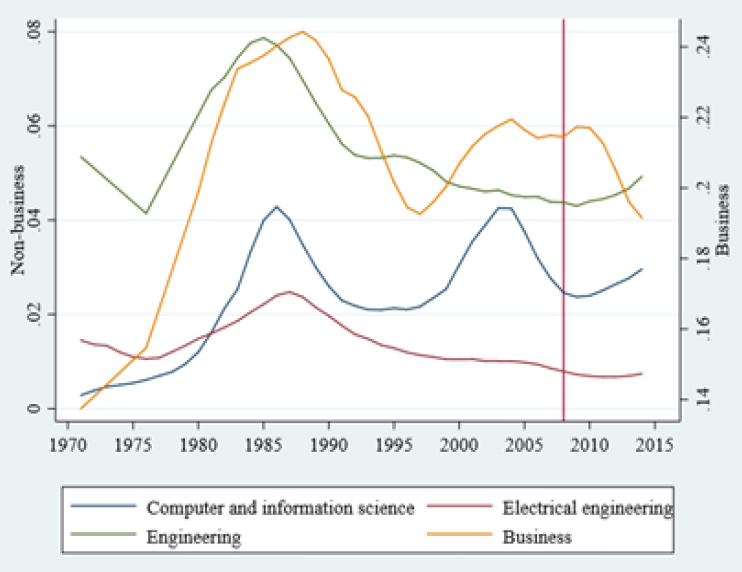
of computer science degrees since 2008. The two booms are therefore likely to have a common cause.
EXPLANATIONS FOR PAST BOOMS AND BUSTS IN COMPUTER SCIENCE DEGREES
The principle of boom and bust in degrees awarded in a particular field was established by Freeman (1975). He explained the theory that a sharp increase in labor demand for a type of college worker initially causes their wages to spike, since in the short run their numbers do not increase much. The wage spike causes enrollment in the field to rise, and with a 4-year lag, the new workers enter the market, depressing the wage. Because students do not realize that the initial spike in the wage is higher than the long-run equilibrium wage, too many students move into the field, and when they graduate, they depress the wage below the equilibrium wage. This then leads to a reduction in the number of students in the field, which raises the wage with a 4-year lag. With these cycles, the wage
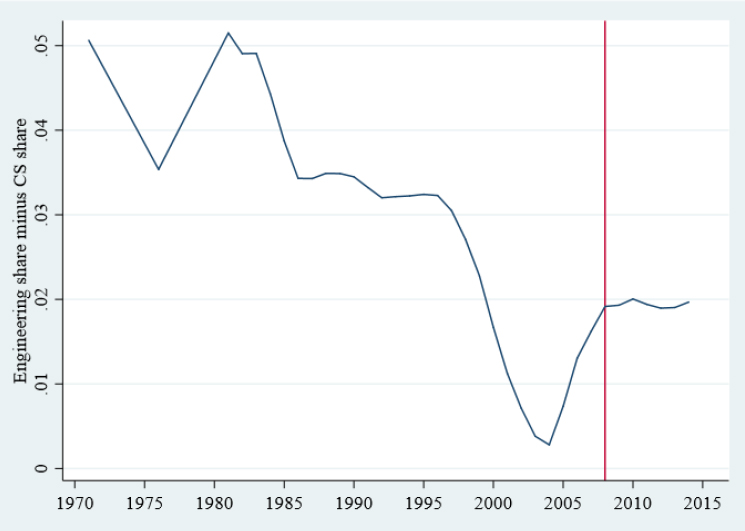
converges to the long-run equilibrium. Freeman showed that the market for physicists worked in this way in response to the founding of NASA and the associated sudden increase in demand for physicists in the 1960s.
Similarly, the late 1970s and early 1980s was a period with a sudden jump in the demand for computer scientists (and electrical engineers) following breakthroughs in semiconductors and microprocessors, while the 1990s was a period with a sudden jump in the demand for computer scientists and programmers (but not electrical engineers) due to the establishment of the World Wide Web and the need to reprogram computers ahead of the turn of the millennium (Y2K). Wages rose, students flocked to majors associated with the booming fields, the response turned out to be greater than that required, and wages and enrollments fell (see, for example, Bound et al., 2013).
ARE COMPUTER SCIENCE DEGREES RISING CURRENTLY BECAUSE DEMAND IS RISING?
The current boom in enrollment and degrees awarded in computer science has not yet received the same attention as the earlier cycles. There has not
been any single technological breakthrough that is obviously on the scale of the breakthroughs that caused the two earlier booms, but it is conceivable that several smaller increases in demand, such as in response to the availability of Big Data, have combined to have a more gradual effect. I turn to labor market data from the Current Population Surveys 1979-2014 to assess whether demand for computer scientists appears to have jumped. These individual-level data do not include information on the field of the bachelor’s (or any other) degree, but permit a long time series.
I begin by examining employment by occupation, to see whether the increased enrollment in computer science (and information technology) bachelor’s programs, reported elsewhere, is reflected in increased employment in computer occupations. Panel A of Figure D.5 shows that the share of workers in computer occupations (blue line) has increased steadily, except for in the early 2000s, overtaking the share in engineering occupations (red line), and increasing fastest in the 1990s.3 Panel B shows the 1990s acceleration is more marked in a sample of college graduates, and that the increase of the recent years contrasts more sharply with the plateau of the early 2000s.
In panel C, I limit the sample to college graduates 22 to 26 years of age, to see more clearly whether the recent increase in employment in panel B is linked to recent graduates. The graph confirms an increase in the share of workers in computer occupations since 2010. This graph also shows clearly earlier boom and bust cycles: employment in computer occupations rose sharply in the early 1980s, before falling for 10 years, then rose the fastest of any period in the second half of the 1990s, before falling rapidly for 5 years.
A 1980s boom and bust in employment in engineering occupations is also clearly visible, though occurring slightly earlier than the computer occupations cycle; there is no 1995-2005 cycle. In contrast to computer science, there is no increase in employment in engineering occupations corresponding to the post-2009 increase in engineering degrees. This apparent puzzle can be explained by the fact that engineering bachelor’s degree holders (graduates) enter a wider variety of jobs than computer science graduates (see also Altonji et al., 2013; Hunt, 2015). American Community Survey data from 2014 show that 51 percent of employed computer science graduates age 22 to 26 worked in computer science occupations, compared to 36 percent of employed engineering graduates who worked in engineering occupations. These data also show that from 2009 to 2014, the share of engineering graduates working in engineering occupations declined 4.7 percentage points, offset by a rise in the share working as managers including engineering managers (up 1.6 percentage points), as professionals in business operations (up 0.8 percentage points—e.g., management analysts), and finance, insurance, and real estate (up 0.4 percentage points).4
___________________
3 Mathematics occupations are included with computer occupations, as the combined group is easier to define consistently over time in the face of changes in occupational codes.
4 Field of bachelor’s degrees is available only in the American Community Survey from 2009.
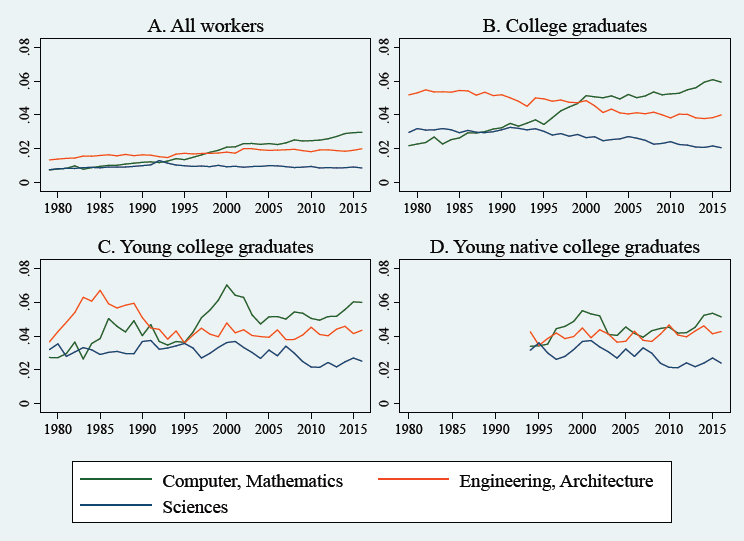
Panel D shows that the recent increase in employment in computer occupations and the 1995-2005 cycle are still visible when I limit the sample to workers born in the United States (data on birthplace are available only from 1994). A comparison of panels C and D shows, however, that foreign-born workers contributed more to the 1990s boom than to the current boom: while for all young college graduates in panel C the 1990s boom dwarfs the current boom, for the native-born in panel D the booms are similar in size, albeit smaller. The important role of an increased number of foreign-born workers in the 1990s boom is well known (e.g., Bound et al., 2015). The H-1B visa cap is now lower (at least for for-profit firms) than it was in that period, so this contrast alone does not rule out a similar jump in labor demand across the two periods.
In Figure D.6, I display real median wages (in 2014 dollars) for the same samples as in Figure D.5. In none of the panels are computer occupation wages (blue line) trending up in recent years, though young workers’ wages fell during the Great Recession and have since recovered. Wages in computer occupations caught up with those of engineering occupations between 1979 and 2000, with spurts corresponding to the employment booms (panel A), and have been on a
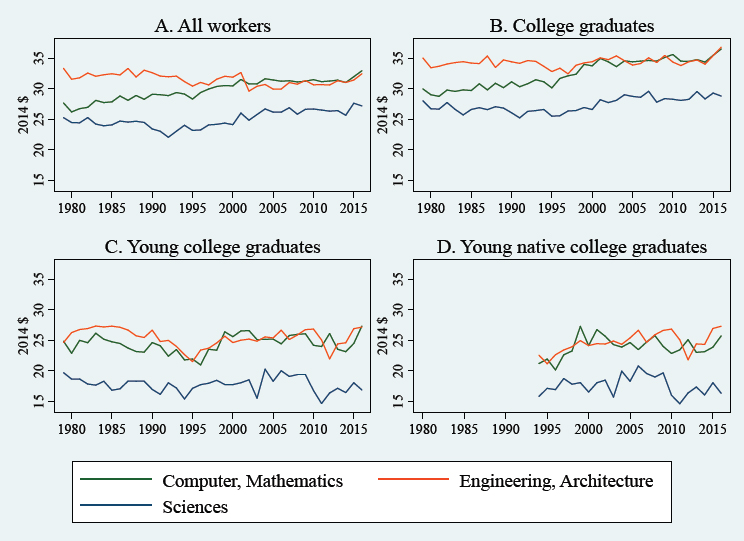
plateau since then. The pattern is similar for college graduates in panel B. Similarly to employment patterns, wage patterns are more cyclical for young college graduates in computer occupations than for all college graduates (panel C). After wage increases in 1980-1985, the period of the employment increase, wages decline sharply for 3 years in the employment bust period. Wages rise to a new peak in 1996-2000, plateau, then decline equally sharply to a plateau that has lasted to the present. Patterns for the native-born in panel D are similar.
The wages of engineering occupations (red line) do not show any increase in the period of the employment expansion in the 1980s in any of the panels (possibly the wage increased before 1979 when the data begin) but do show a decline as employment in those occupations declined. The fact that engineering occupation wages grew in the late 1990s despite an obvious cause or an increase in employment suggests that some of the (greater) wage gain in computer occupations may reflect the generally booming economy and rising wages in the late 1990s.5
___________________
5 Patterns are similar to Figure D.6 if we use weekly wages, or the 75th percentile of hourly wages.
Looking at patterns of employment and wages is not enough to determine whether supply or demand or both are shifting, but nevertheless, the contrast between the current increase in computer science degrees and employment with no change in wages and earlier booms, which were accompanied or preceded by rise in wages, is very suggestive, ruling out a recent sudden increase in demand for computer science graduates as the sole explanation. The most likely explanation is that demand has indeed shifted somewhat, but that a concurrent shift in supply has kept wages constant even several years after the demand increase, dampening the Freeman-style cycle that the shift in demand would normally have stimulated. In other words, the increase in enrollment, degrees, and employment is in part spurred by something other than wages. A similar conclusion can be reached about supply and demand for engineering graduates.
WHAT COULD HAVE CAUSED THE DEMAND FOR COMPUTER SCIENCE MAJORS TO SHIFT OUT?
There is a common view that there is currently unprecedented progress in computer science that is likely to have increased demand for computer science majors. This view must be reconciled with the similar patterns in number of majors and wages for engineering majors. While it is possible that the two groups are subject to different supply and demand forces that happen to be the same size, a simpler explanation is that the two groups are subject to the same forces. A possible common force on the demand side would be an increase in demand for college graduates with quantitative skills. Another would be technological breakthroughs in the joint use of digital and mechanical technology, such as robotics: the rise of mechatronics as a vocational degree is consistent with this. The fact that the increased number of engineering graduates is not translating into increased employment in engineering or computer occupations seems supportive of the first theory.
WHAT COULD HAVE CAUSED THE SUPPLY OF COMPUTER SCIENCE MAJORS TO SHIFT OUT?
One possible explanation for the increased attraction of computer science and engineering degrees could be the Great Recession: students shifted to majors that weather recessions better. Altonji et al. (2013) show that prior to the Great Recession (though less so during the Great Recession), science, technology, engineering, and mathematics majors graduating in a recession suffered less deterioration of their employment and wage outcomes than other majors. The timing of the increased computer science and engineering degrees is fairly consistent with this (see Figure D.3, where the red vertical line indicates 2008). The shift in preferences over majors cannot have been simply toward practical majors, as Figure D.3 shows a large fall in bachelor’s degrees in business since the reces-
sion (note the use of the right-hand scale).6 Another possibility is that computer science jobs or careers have become more attractive because the nature of the tasks performed in the jobs or the objects of inquiry have become more interesting, or because they have become interesting to a wider group, such as women. The percent increase in computer science degrees awarded to women since 2009 has been the same as for men, and women receive a small minority of computer science degrees (22 percent in 2014). Increased appeal to women therefore does not seem to be an explanation.
CONCLUSION
Since 2009 there has been an increase in the number of computer and information science bachelor’s degrees similar in speed and magnitude to the increase induced by the 1990s dot-com and Y2K-related demand. However, both speed and magnitude are more modest than earlier booms when measured as a share of bachelor’s degrees awarded. Furthermore, there has been an equal increase in the share of engineering bachelor’s degrees, suggesting that common forces may be affecting the two fields. Data on employment and wages suggest the increase in computer science and engineering bachelor’s degrees is caused by the combination of a moderate shift out (increase) in labor demand and a moderate shift out (increase) in labor supply—that is, some of the increase in enrollment is responding to something other than wages. The shift out in demand may be caused by higher demand for quantitative skills, or new developments in the joint use of digital and mechanical technology, such as robotics. The shift out in supply may reflect a move toward recession-proof majors.
REFERENCES
Altonji, Joseph G., Lisa B. Kahn, and Jamin D. Speer. 2013. Cashier or Consultant? Entry Labor Market Conditions, Field of Study, and Career Success. Yale University working paper.
Bound, John, Breno Braga, Joseph M. Golden, and Sarah Turner. 2013. Pathways to adjustment: The case of information technology workers. American Economic Review 103(3): 203-207.
Bound, John, Breno Braga, Joseph M. Golden, and Gaurav Khanna. 2015. Recruitment of foreigners in the market for computer scientists in the United States. Journal of Labor Economics 33(3): S187-S223.
Freeman, Richard B. 1975. Supply and salary adjustments to the changing science manpower market: Physics, 1948-1973. American Economic Review 65(1): 27-39.
Hunt, Jennifer. 2015. Are immigrants the most skilled US computer and engineering workers? Journal of Labor Economics 33(3): S39-S77.
___________________
6 The juxtaposition of these lines begs the question of whether some degrees previously called business degrees might have been renamed as information science degrees.










